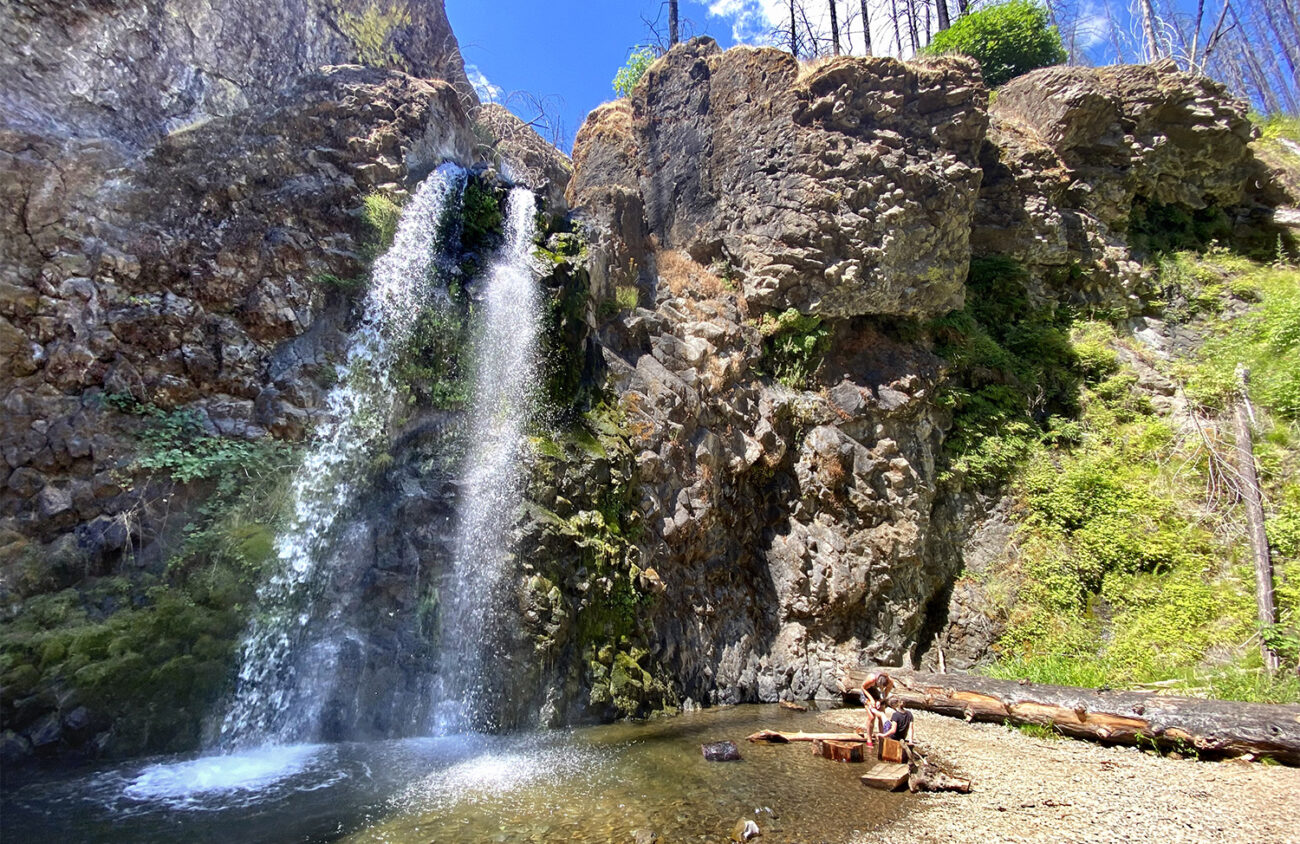A wildfire in 2020 destroyed the waterfall trails of the North Umpqua River, right?
Well, no. The jungly 1.3-mile path to Wolf Creek Falls didn’t burn at all, and the most spectacular of the burned trails, a 0.9-mile path to Fall Creek Falls, is actually more interesting without trees.
Both hikes are fun for kids — easy walks with lots of creek pools to splash in.
I know, it’s hard to recommend a day with four hours of driving for three hours of hiking. So make a weekend of it, staying in one of the many riverside campgrounds along the North Umpqua. These two waterfall hikes are also great for stretching your legs if you are on your way to Crater Lake, a quiet destination in autumn.
Start by driving Interstate 5 south to Roseburg. Take exit 124, follow “Diamond Lake” signs through town to Highway 138, and drive 16 miles to Glide — an otherwise sleepy logging town with a Community Hall that hosts a great wildflower show each spring. There’s also the Colliding Rivers picnic area where the North Umpqua and Little River really do smash head-to-head along an old fault rift.
At the start of Glide, just after milepost 16, turn right on Little River Road for 10.8 paved miles to the Wolf Creek Trailhead. Some parking is on the right by a footbridge, but there’s more room in a picnic area 100 feet further, on the left.
Begin the hike by crossing the 150-foot arched footbridge over the Little River. Before you rush down to the riverbank here to skip rocks, be aware that this is the only place on the hike with poison oak. So perhaps you should stick to the trail. After 0.2 miles, the path crosses Wolf Creek on a 40-foot bridge and sallies up an unburned valley with giant Douglas-fir and redcedar trees five feet in diameter. In fall the vine maple leaves here turn scarlet. In early summer, the path is lined with so many different woodland wildflowers that you’ll lose count: wild ginger, solomonseal, oxalis, trillium and vanilla leaf. In any season look for four kinds of ferns — sword ferns, deer ferns, lady ferns and maidenhair ferns.
Shortly after the Wolf Creek bridge a side trail to the left leads to a picnic table at a creekside campsite that’s open to backpackers for free, first come first served.
After 1.3 miles the trail skirts a 20-foot lower falls. Then the path ends at a viewpoint of the dramatic 70-foot sliding cascade of Wolf Creek Falls. Listen here for the “zeet! zeet!” call of water ouzels flying along the creek.
After hiking to Wolf Creek Falls you might be ready to head for home.
Or not? If you have time for just one more waterfall hike in this river canyon, make it Fall Creek Falls. This trail is in the heart of the 2020 burn, so the 0.9-mile path is palisaded with black snags. No matter. The burn allows you to see all the weird lava formations of the creek’s canyon. And green is rushing back as maple saplings, elderberry bushes, willow and snowbrush stake their claim to sun. Summer blooms along the creek include a scarlet monkeyflower that I like to call fire monkey.
To drive to the Fall Creek Falls trailhead from Glide, take Hwy 138 east 16 miles toward Diamond Lake. Between mileposts 32 and 33, pull into a signed parking area on the left.
The North Umpqua has long been a conduit for lava flows from the High Cascade volcanoes near Crater Lake. In Fall Creek’s canyon the flows eddied and cooled slowly, cracking into contorted outcrops of twisted columnar basalt. This kind of lava fractures hexagonally as it cools, forming pillars that are perpendicular to the cooling surface.
The trail meanders through a labyrinth of rock slots as it climbs. At the falls itself the creek is tortured into two sets of twisting cataracts before landing in a wadable pool with a gravel beach and a waterfall shower.
Continue 300 feet up to a railed upper viewpoint, a good turnaround point. Don’t bother hiking up to a private road, and you can skip the signed 0.1-mile side path to Jobs Garden, a rocky pit. Especially if you’re hiking with kids, you need to stick to the basics — short, fun trails with water features. The North Umpqua has hikes that are just the ticket. ν
William L. Sullivan is the author of 23 books, including The Ship In The Woods And The Updated 100 Hikes Series For Oregon. Learn more at OregonHiking.com.

